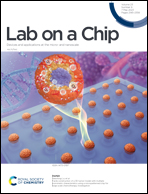AC-electric-field-controlled multi-component droplet coalescence at microscale†
Abstract
Droplet coalescence with fast response, high controllability and monodispersity has been widely investigated in industrial production and bioengineering. Especially for droplets with multiple components, programmable manipulation of such droplets is crucial for practical applications. However, precise control of the dynamics can be challenging, owing to the complex boundaries and the interfacial and fluidic properties. AC electric fields, with their fast response and high flexibility, have attracted our interest. We design and fabricate an improved flow-focusing microchannel configuration together with a non-contact type of electrode featuring asymmetric geometries, based on which we conduct systematic investigations of the AC-electric-field-controlled coalescence of multi-component droplets at the microscale. Parameters such as flow rates, component ratio, surface tension, electric permittivity and conductivity were given our attention. The results show that droplet coalescence in different flow parameters can be achieved in milliseconds by adjusting the electrical conditions, which shows high controllability. Specifically, both the coalescence region and reaction time can be adjusted by a combination of applied voltage and frequency, and unique merging phenomena have appeared. One is contact coalescence with the approach of paired droplets, while the other is squeezing coalescence, which occurs in the start position and promotes the merging process. The fluid properties, such as the electric permittivity, conductivity and surface tension, present a significant influence on merging behavior. The increasing relative dielectric constant leads to a dramatic reduction of the start merging voltage from the original 250 V to 30 V. The range of effective voltage for coalescence decreases with the addition of surfactant, offering a stricter and yet higher selectivity on electrical conditions, about 1500 V. The conductivity presents a negative correlation with the start merging voltage due to the reduction of the dielectric stress, from 400 V to 1500 V. Finally, we achieve the precise fabrication process of the Janus droplet via implementation of the proposed method, where the components of the droplets and the coalescence conditions are well controlled. Our results can serve as a potent methodology to decipher the physics of multi-component droplet electro-coalescence and contribute to applications in chemical synthesis, bioassay and material synthesis.



 Please wait while we load your content...
Please wait while we load your content...